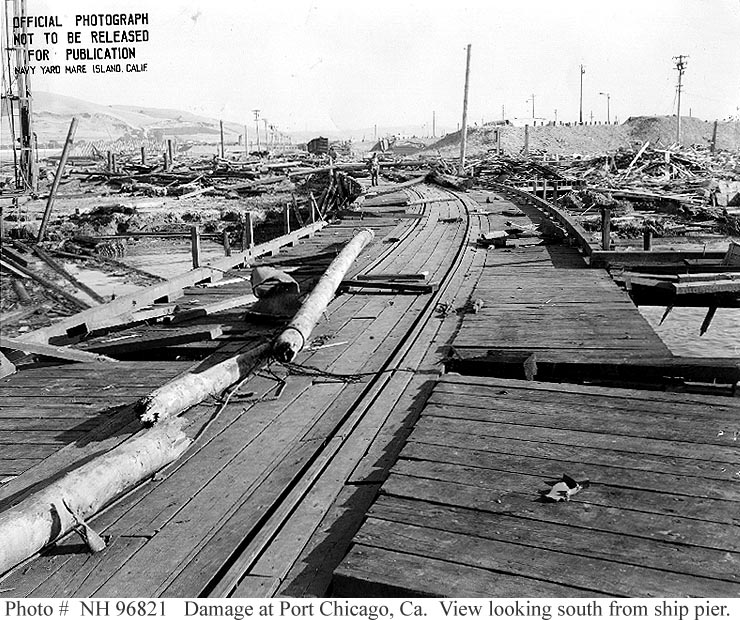 07-17-15, 10:48 AM
07-17-15, 10:48 AM
|
#865
|
|
Gefallen Engel U-666
Join Date: Jul 2013
Location: On a tilted, overheated, overpopulated spinning mudball on Collision course with Andromeda Galaxy
Posts: 30,121
Downloads: 24
Uploads: 0
|
 22:18: What a mess!
22:18: What a mess!
1944: 320 men, 2/3 of them African-Americans, are killed, and 390 more injured, when two ammunition ships explode at Port Chicago Naval Magazine in san Francisco Bay California. The holds were being packed with 4,600 tons of explosives–bombs, depth charges and ammunition. Another 400 tons of explosives were nearby on rail cars. The explosion cast a 'mushroom style' cloud 18,000 feet into the air. The pilot of a plane flying at 9,000 feet in the area claimed that metal chunks from the explosion flew past him. The blasts were felt as far away as Nevada and the resulting damage extended as far as San Francisco
A month later, continuing unsafe conditions inspired hundreds of servicemen to refuse to load munitions, an act known as the Port Chicago Mutiny. Fifty men—called the "Port Chicago 50"—were convicted of mutiny and sentenced to long prison terms. Forty-seven of the 50 were released in January 1946; the remaining three served additional months in prison. The NAACP had given the mutiny trial top importance due to the U.S. Navy's policy of putting Negroes into dirty and dangerous jobs with no hope of advancement.
There was no system at Port Chicago for making sure officers and men were familiar with safety regulations. Two formal lectures and several informal lectures were given to the enlisted men by commanding officers, but follow-up confirmation of retained knowledge did not take place.
The enlisted men were leery of working with deadly explosives but were told by officers that the larger munitions were not active and could not explode—that they would be armed with their fuzes upon arrival at the combat theater. Handling of larger munitions, such as bombs and shells, involved using levers and crowbars from individual munitions with levers and crowbars from boxcars, in which they were packed tightly with dunnage—lifting the heavy, grease-coated cylinders, rolling them along the wooden pier, packing them into nets, lifting them by winch and boom, lowering the bundle into the hold, then dropping individual munitions by hand a short distance into place. This series of actions was rough enough that damaged naval shells sometimes leaked identification dye from their ballistic caps. 
Commander Paul B. Cronk, head of a Coast Guard explosives-loading detail tasked with supervision of the working dock, warned the Navy that conditions were unsafe and ripe for disaster. The Navy refused to change its procedures and Cronk withdrew the detail. In 1994, the Navy rejected a request by four California lawmakers to overturn the courts-martial decisions. The Navy found that racial inequities were responsible for the sailors' ammunition-loading assignments but that no prejudice occurred at the courts-martial. In the 1990s, Freddie Meeks, one of the few still alive among the group of 50, was urged to petition the President for apardon. Others of the Port Chicago 50 had refused to ask for a pardon, reasoning that a pardon is for guilty people receiving forgiveness; they continued to hold the position that they were not guilty of mutiny. Meeks pushed for a pardon as a way to get the story out, saying "I hope that all of America knows about it... it's something that's been in the closet for so long." In September 1999, the petition by Meeks was bolstered by 37 members of Congress including the U.S. representative for the district containing the disaster site. The 37 Congressmen sent a letter to President Clinton, and in December 1999 Clinton pardoned Meeks. [wiki] In 1994, the Navy rejected a request by four California lawmakers to overturn the courts-martial decisions. The Navy found that racial inequities were responsible for the sailors' ammunition-loading assignments but that no prejudice occurred at the courts-martial. In the 1990s, Freddie Meeks, one of the few still alive among the group of 50, was urged to petition the President for apardon. Others of the Port Chicago 50 had refused to ask for a pardon, reasoning that a pardon is for guilty people receiving forgiveness; they continued to hold the position that they were not guilty of mutiny. Meeks pushed for a pardon as a way to get the story out, saying "I hope that all of America knows about it... it's something that's been in the closet for so long." In September 1999, the petition by Meeks was bolstered by 37 members of Congress including the U.S. representative for the district containing the disaster site. The 37 Congressmen sent a letter to President Clinton, and in December 1999 Clinton pardoned Meeks. [wiki]   Well, I'll be sailing past this location later today ...in silence. Well, I'll be sailing past this location later today ...in silence.
Last edited by Aktungbby; 07-18-15 at 12:46 AM.
|

|

|